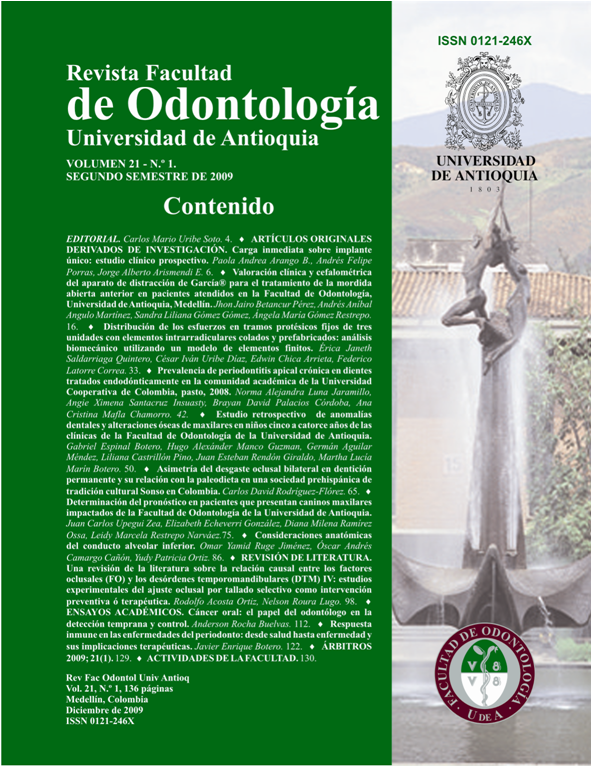Prevalence of chronic apical periodontitis in endodontically treated teeth in the academic community at Universidad Cooperativa de Colombia, Pasto, 2008
DOI:
https://doi.org/10.17533/udea.rfo.2192Keywords:
Prevalence, Chronic apical periodontitis, Endodontics, RestorationAbstract
Introduction: to determine the prevalence of chronic apical periodontitis in endodontically treated teeth in the academic community at Universidad Cooperativa de Colombia, Pasto. Methods: a cross-sectional study was designed where a sample of 37 individuals and 49 endodontically treated teeth were included. They were screened by two examiners to determine the prevalence of chronic apical periodontitis and related variables such as age, gender, teeth, quality of endodontic filling, dental caries, and type and quality of restoration. Inter-examiner Cohen’s Kappa index was done. Results: chronic apical periodontitis (CAP) was evident in 79.6% of all endodontic treated teeth. Of teeth with CAP, 56.4% belonged to men and 43.6% to women. Premolars had a greater prevalence of chronic apical periodontitis than molars. According to endodontic fillings seal, only 24.3% with adequate seal did not have chronic apical periodontitis. The 12.2% of the endodontically treated teeth were considered technically adequate. Teeth restored with composite had severe CAP. Conclusions: this study determined that in this population there is a high prevalence of chronic apical periodontitis. Variables such as gender, type of tooth, root filling quality, dental caries and restoration quality influence the CAP presence.
Downloads
Downloads
Published
How to Cite
Issue
Section
License
Copyright Notice
Copyright comprises moral and patrimonial rights.
1. Moral rights: are born at the moment of the creation of the work, without the need to register it. They belong to the author in a personal and unrelinquishable manner; also, they are imprescriptible, unalienable and non negotiable. Moral rights are the right to paternity of the work, the right to integrity of the work, the right to maintain the work unedited or to publish it under a pseudonym or anonymously, the right to modify the work, the right to repent and, the right to be mentioned, in accordance with the definitions established in article 40 of Intellectual property bylaws of the Universidad (RECTORAL RESOLUTION 21231 of 2005).
2. Patrimonial rights: they consist of the capacity of financially dispose and benefit from the work trough any mean. Also, the patrimonial rights are relinquishable, attachable, prescriptive, temporary and transmissible, and they are caused with the publication or divulgation of the work. To the effect of publication of articles in the journal Revista de la Facultad de Odontología, it is understood that Universidad de Antioquia is the owner of the patrimonial rights of the contents of the publication.
The content of the publications is the exclusive responsibility of the authors. Neither the printing press, nor the editors, nor the Editorial Board will be responsible for the use of the information contained in the articles.
I, we, the author(s), and through me (us), the Entity for which I, am (are) working, hereby transfer in a total and definitive manner and without any limitation, to the Revista Facultad de Odontología Universidad de Antioquia, the patrimonial rights corresponding to the article presented for physical and digital publication. I also declare that neither this article, nor part of it has been published in another journal.
Open Access Policy
The articles published in our Journal are fully open access, as we consider that providing the public with free access to research contributes to a greater global exchange of knowledge.
Creative Commons License
The Journal offers its content to third parties without any kind of economic compensation or embargo on the articles. Articles are published under the terms of a Creative Commons license, known as Attribution – NonCommercial – Share Alike (BY-NC-SA), which permits use, distribution and reproduction in any medium, provided that the original work is properly cited and that the new productions are licensed under the same conditions.
![]()
This work is licensed under a Creative Commons Attribution-NonCommercial-ShareAlike 4.0 International License.













